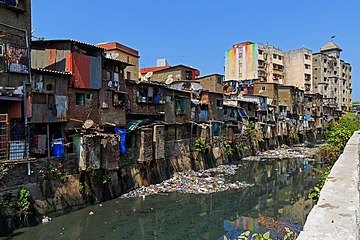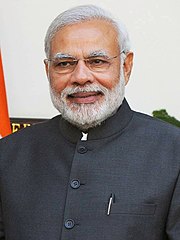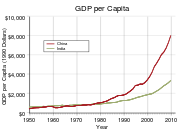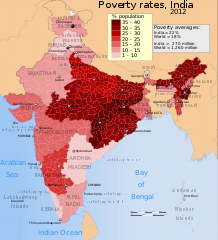Dieses Wiki, das alte(!) Projektwiki (projektwiki.zum.de)
wird demnächst gelöscht.
Bitte sichere Deine Inhalte zeitnah,
wenn Du sie weiter verwenden möchtest.
Gerne kannst Du natürlich weiterarbeiten
im neuen Projektwiki (projekte.zum.de).Poverty in India: Unterschied zwischen den Versionen
| Zeile 22: | Zeile 22: | ||
=== Reduction of poverty by the government === | === Reduction of poverty by the government === | ||
Since 1950 the government of India tries to reduce the poverty, for example by subsidising groceries and other vital necessities for example through the "National Food Security Bill" from 2013. The government also developed a better education system and helped eradicating disparities between rural and urbanized areas for example trough the "Mahatma Gandhi National Rural Employment Guarentee Scheme" from 2005; through this and other laws the government increased the access to better wages (minimunm wages). <ref>http://www.bpb.de/internationales/asien/indien/189202/grosse-armut-und-zunehmende-ungleichheit (german), last accessed 16.01.2019</ref><ref>National Food Security Act 2013: https://www.india.gov.in/national-food-security-act-2013</ref><ref>Ministry of Rural Development, India: http://nrega.nic.in/netnrega/home.aspx</ref> | Since 1950 the government of India tries to reduce the poverty, for example by subsidising groceries and other vital necessities for example through the "National Food Security Bill" from 2013. The government also developed a better education system and helped eradicating disparities between rural and urbanized areas for example trough the "Mahatma Gandhi National Rural Employment Guarentee Scheme" from 2005; through this and other laws the government increased the access to better wages (minimunm wages). <ref>http://www.bpb.de/internationales/asien/indien/189202/grosse-armut-und-zunehmende-ungleichheit (german), last accessed 16.01.2019</ref><ref>National Food Security Act 2013: https://www.india.gov.in/national-food-security-act-2013</ref><ref>Ministry of Rural Development, India: http://nrega.nic.in/netnrega/home.aspx</ref> | ||
| − | + | [[File:PM Modi 2015.jpg|thumb|Narendra Modi 2015]] | |
| + | ==== ModiCare ==== | ||
| + | Founded by the current indian Prime Minister [https://en.wikipedia.org/wiki/Narendra_Modi Narendra Modi], "''Modi Care''" is the world's biggest health insurrance scheme. It should help the poor population (under the poverty line of indian government: 26 rupees a day) to get better access to healt care. The government estimates costs of 1.6 billion dollars per year but it would help about 100 million families. | ||
=== Uprising industry in India === | === Uprising industry in India === | ||
| − | [[File:GDP per capita of China and India.svg|thumb|GDP per capita of China and India]] | + | [[File:GDP per capita of China and India.svg|thumb|links|GDP per capita of China and India]] |
India has one the fastest growing economies in the world. In 2017 India had a GDP ([https://en.wikipedia.org/wiki/Gross_domestic_product Gross domestic product]) grwoth rate of 6.7%<ref>Data for India by the "Internation Monetary Fund (IMF)": https://www.imf.org/en/Countries/IND, last accessed 16.01.2019</ref> (still increasing), while Germany had a growth rate of 2.5%<ref>Data for Germany by the "Internation Monetary Fund (IMF)": https://www.imf.org/en/Countries/DEU , last accessed 16.01.2019</ref> (aim: continual and appropriate economic growth (StabG)<ref>"Stabilitäts- und Wachstumsgesetz (StabG)" - Law in furtherance of economic growth [...]: http://www.gesetze-im-internet.de/stabg/ (german), last accessed 16.01.2019</ref>. | India has one the fastest growing economies in the world. In 2017 India had a GDP ([https://en.wikipedia.org/wiki/Gross_domestic_product Gross domestic product]) grwoth rate of 6.7%<ref>Data for India by the "Internation Monetary Fund (IMF)": https://www.imf.org/en/Countries/IND, last accessed 16.01.2019</ref> (still increasing), while Germany had a growth rate of 2.5%<ref>Data for Germany by the "Internation Monetary Fund (IMF)": https://www.imf.org/en/Countries/DEU , last accessed 16.01.2019</ref> (aim: continual and appropriate economic growth (StabG)<ref>"Stabilitäts- und Wachstumsgesetz (StabG)" - Law in furtherance of economic growth [...]: http://www.gesetze-im-internet.de/stabg/ (german), last accessed 16.01.2019</ref>. | ||
| Zeile 37: | Zeile 39: | ||
=== Living Expenses in India === | === Living Expenses in India === | ||
Estimatedly in India you need 130 rupees to live a sufficent wealthy life | Estimatedly in India you need 130 rupees to live a sufficent wealthy life | ||
| + | |||
| + | |||
== Political problems == | == Political problems == | ||
Version vom 16. Januar 2019, 23:13 Uhr
Despite of remarkable economic growth India is still one of the poorest countries of the world. India is also one of the biggest countries in the world with a population of 1.35 billion[1] (January 2019) and more than 13% live with $1.90 a day[2]
Inhaltsverzeichnis |
History and economical progress
The number of people living in extreme poverty has changed quickly in years past. According to the World Bank more than 90 million has escaped extreme poverty in the period between 2011/2012 and 2015. Also the townscapes in the urbanized regions have changed; the number of the poor population in cities has decreased as well.
| Poverty | Number of poor (million) | Rate (%) | Period |
|---|---|---|---|
| National Poverty Line | 273.1 | 21.9 | 2011 |
| International Poverty Line US $1.90 (2011 PPP) per day per capita | 175.7 | 13.4 | 2015 |
| Lower Middle Income Class Poverty Line US $3.20 (2011 PPP) per day per capita | 659.2 | 50.4 | 2015 |
| Upper Middle Income Class Poverty Line US $5.50 (2011 PPP) per day per capita | 1,077.0 | 82.3 | 2015 |
The "World Poverty Clock" predicts that untill the beginnig of the year 2020 less than 3% of the total population will live in extreme poverty (currently: 3.6% according to "World Poverty Clock")[3]
Reduction of poverty by the government
Since 1950 the government of India tries to reduce the poverty, for example by subsidising groceries and other vital necessities for example through the "National Food Security Bill" from 2013. The government also developed a better education system and helped eradicating disparities between rural and urbanized areas for example trough the "Mahatma Gandhi National Rural Employment Guarentee Scheme" from 2005; through this and other laws the government increased the access to better wages (minimunm wages). [4][5][6]
ModiCare
Founded by the current indian Prime Minister Narendra Modi, "Modi Care" is the world's biggest health insurrance scheme. It should help the poor population (under the poverty line of indian government: 26 rupees a day) to get better access to healt care. The government estimates costs of 1.6 billion dollars per year but it would help about 100 million families.
Uprising industry in India
India has one the fastest growing economies in the world. In 2017 India had a GDP (Gross domestic product) grwoth rate of 6.7%[7] (still increasing), while Germany had a growth rate of 2.5%[8] (aim: continual and appropriate economic growth (StabG)[9].
An important sector in the uprising industry of India became the IT/Software-sector just recently. The software-industry was freed by regulations and patronising by the government and bureaucracy as it was the case in other sectors as a part of command economy in India. Because of the IT-sector India was seen as an international economyplayer again.[10]
The economic progress also has an influence on the national prosperity of the country. The labour force increased and also the employmentrates in "higher" paied jobs did: The rate of employees in wage employement increased by approximatly 8% in the period of 1993 untill 2012[11]
Poverty prevalence
Living Expenses in India
Estimatedly in India you need 130 rupees to live a sufficent wealthy life
Political problems
Manipulation
References
- ↑ Accoridng to recent data: http://www.indiaonlinepages.com/population/india-current-population.html
- ↑ 2,0 2,1 Accordind to poverty data of India by the World bank: http://povertydata.worldbank.org/poverty/country/IND
- ↑ "World Poverty Clock" by World Data Lab in Vienna: https://worldpoverty.io/, last accessed 16.01.2019
- ↑ http://www.bpb.de/internationales/asien/indien/189202/grosse-armut-und-zunehmende-ungleichheit (german), last accessed 16.01.2019
- ↑ National Food Security Act 2013: https://www.india.gov.in/national-food-security-act-2013
- ↑ Ministry of Rural Development, India: http://nrega.nic.in/netnrega/home.aspx
- ↑ Data for India by the "Internation Monetary Fund (IMF)": https://www.imf.org/en/Countries/IND, last accessed 16.01.2019
- ↑ Data for Germany by the "Internation Monetary Fund (IMF)": https://www.imf.org/en/Countries/DEU , last accessed 16.01.2019
- ↑ "Stabilitäts- und Wachstumsgesetz (StabG)" - Law in furtherance of economic growth [...]: http://www.gesetze-im-internet.de/stabg/ (german), last accessed 16.01.2019
- ↑ "Wirtschaftssystem und wirtschaftliche Entwicklung in Indien" auf bpb.de : http://www.bpb.de/internationales/asien/indien/44512/ueberblick-wirtschaft
- ↑ India Wage Report 2018 by the "International Labour Organization (ILO)": https://www.ilo.org/wcmsp5/groups/public/---asia/---ro-bangkok/---sro-new_delhi/documents/publication/wcms_638305.pdf





